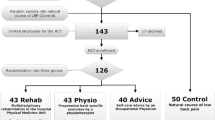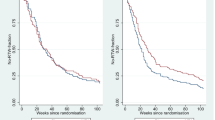Abstract
The objective of this study is to compare the costs and benefits of a graded activity (GA) intervention to usual care (UC) for sick-listed workers with non-specific low back pain (LBP). The study is a single-blind, randomized controlled trial with 3-year follow-up. A total of 134 (126 men and 8 women) predominantly blue-collar workers, sick-listed due to LBP were recruited and randomly assigned to either GA (N = 67; mean age 39 ± 9 years) or to UC (N = 67; mean age 37 ± 8 years). The main outcome measures were the costs of health care utilization during the first follow-up year and the costs of productivity loss during the second and the third follow-up year. At the end of the first follow-up year an average investment for the GA intervention of €475 per worker, only €83 more than health care utilization costs in UC group, yielded an average savings of at least €999 (95% CI: −1,073; 3,115) due to a reduction in productivity loss. The potential cumulative savings were an average of €1,661 (95% CI: −4,154; 6,913) per worker over a 3-year follow-up period. It may be concluded that the GA intervention for non-specific LBP is a cost-beneficial return-to-work intervention.

Similar content being viewed by others
References
Courtney TK, Matz S, Webster BS (2002) Disabling occupational injury in the US construction industry, 1996. J Occup Environ Med 44:1161–1168
Dutch Central Organisation for Health Care Charge, Utrecht (1998) Tariffs for medical specialist, excluding psychiatrists. Supplement to tariffs decision number 5600-1900-1 from 10 December 1998 [in Dutch: Het tariefboek voor medisch specialist, exclusief psychiaters. De bijlage bij tariefbeschikking 5600-1900-1 d.d. 10 december 1998]
Elders LA, Burdorf A (2004) Prevalence, incidence, and recurrence of low back pain in scaffolders during a 3-year follow-up study. Spine 29:101–106
Elders LA, van der Beek AJ, Burdorf A (2000) Return to work after sickness absence due to back disorders—a systematic review on intervention strategies. Int Arch Occup Environ Health 73:339–348
Gatchel RJ, Polatin PB, Noe C, Gardea M, Pulliam C, Thompson J (2003) Treatment- and cost-effectiveness of early intervention for acute low-back pain patients: a one-year prospective study. J Occup Rehabil 13:1–9
Goetzel RZ, Hawkins K, Ozminkowski RJ, Wang S (2003) The health and productivity cost burden of the “top 10” physical and mental health conditions affecting six large U.S. employers in 1999. J Occup Environ Med 45:5–14
Hagen EM, Eriksen HR, Ursin H (2000) Does early intervention with a light mobilization program reduce long-term sick leave for low back pain? Spine 25:1973–1976
Hagen EM, Grasdal A, Eriksen HR (2003) Does early intervention with a light mobilization program reduce long-term sick leave for low back pain: a 3-year follow-up study. Spine 28:2309–2315
Indahl A, Velund L, Reikeraas O (1995) Good prognosis for low back pain when left untampered. A randomized clinical trial. Spine 20:473–477
Indahl A, Haldorsen EH, Holm S, Reikeras O, Ursin H (1998) Five-year follow-up study of a controlled clinical trial using light mobilization and an informative approach to low back pain. Spine 23:2625–2630
Karjalainen K, Malmivaara A, Mutanen P, Roine R, Hurri H, Pohjolainen T (2004) Mini-intervention for subacute low back pain: two-year follow-up and modifiers of effectiveness. Spine 29:1069–1076
Kessler RC, Adler L, Ames M, et al (2005) The World Health Organization Adult ADHD Self-Report Scale (ASRS): a short screening scale for use in the general population. Psychol Med 35:245–256
Koopmanschap MA (2005) PRODISQ: a modular questionnaire on productivity and disease for economic evaluation studies. Expert Rev Pharmacoeconomics Outcomes Res 5(1):23–28
Lindstrom I, Ohlund C, Eek C, et al (1992) The effect of graded activity on patients with subacute low back pain: a randomized prospective clinical study with an operant-conditioning behavioral approach. Phys Ther 72:279–290
Loisel P, Abenhaim L, Durand P, et al (1997) A population-based, randomized clinical trial on back pain management. Spine 22:2911–2918
Loisel P, Lemaire J, Poitras S, et al (2002) Cost–benefit and cost–effectiveness analysis of a disability prevention model for back pain management: a six year follow up study. Occup Environ Med 59:807–815
Maetzel A, Li L (2002) The economic burden of low back pain: a review of studies published between 1996 and 2001. Best Pract Res Clin Rheumatol 16:23–30
Maniadakis N, Gray A (2000) The economic burden of back pain in the UK. Pain 84:95–103
Oostenbrink J, Koopmanschap M, van Rutten F (2000) Handbook for cost studies, methods and guidelines for economic evaluation in health care (in Dutch: Handleiding voor kostenonderzoek, methoden en richtlijnprijzen voor economische evaluaties in de gezondheidszorg). Health Care Insurance Council
Perez A, Dennis RJ, Gil JF, Rondon MA, Lopez A (2002) Use of the mean, hot deck and multiple imputation techniques to predict outcome in intensive care unit patients in Colombia. Stat Med 21:3885–3896
Staal JB, Hlobil H, Twisk JW, Smid T, Koke AJ, van Mechelen W (2004) Graded activity for low back pain in occupational health care: a randomized, controlled trial. Ann Int Med 140:77–84
Taxe report (2000) Z-index (in Dutch). The Hague
Williams DA, Feuerstein M, Durbin D, Pezzullo J (1998) Health care and indemnity costs across the natural history of disability in occupational low back pain. Spine 23:2329–2336
Woolf AD, Pfleger B (2003) Burden of major musculoskeletal conditions. Bull World Health Organ 81:646–656
Acknowledgment
Grant support: by the Dutch Health Insurance Executive Council (CVZ), grant DPZ 169/0.
Author information
Authors and Affiliations
Corresponding author
About this article
Cite this article
Hlobil, H., Uegaki, K., Staal, J.B. et al. Substantial sick-leave costs savings due to a graded activity intervention for workers with non-specific sub-acute low back pain. Eur Spine J 16, 919–924 (2007). https://doi.org/10.1007/s00586-006-0283-9
Received:
Revised:
Accepted:
Published:
Issue Date:
DOI: https://doi.org/10.1007/s00586-006-0283-9




